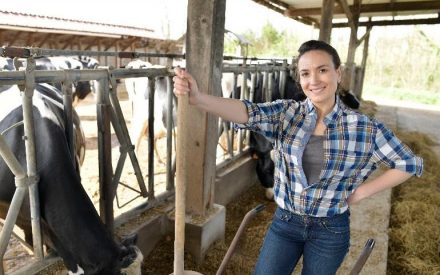The place we are born can impact our culture—our behavior and how we view the world. People who come from different countries have different cultures; the more we interact with people from different countries the more we learn about our cultural differences and similarities. Understanding and valuing cultural differences is important to improving farm business culture.
As dairy herd size in the United States continue to increase, so does the need for a well-trained workforce to milk those high producing cows. Immigrant workers have become essential in dairy operations accounting for 51% of all labor—dairies hiring immigrant labor produce 79% of milk supply in the U.S.1 Most immigrant workers come from Mexico and other countries in Latin America characterized by different cultural identities which make them culturally diverse and unique.

Languages spoken is a good example of the diversity and uniqueness of Latin Americans (Figure 1). Spanish is the most frequent language spoken in Latin America except for Brazil (Portuguese), Suriname (Dutch), Guyana (English), and French Guiana (French). In Spanish-speaking countries, there are indigenous languages that are also considered the main language spoken. Some examples of indigenous languages are: nahuatl (Mexico), mayan languages (Mexico, Guatemala), guarani (Paraguay, Bolivia, Argentina), quechua (Peru, Bolivia, Ecuador, Argentina, Chile, Colombia), aymara (Bolivia, Peru), and mapundungun (Chile, Argentina).
Demographics of Immigrant Dairy Workers in Wisconsin
A study conducted between 2012 and 2015 in Wisconsin reported demographics of Latin/Hispanic dairy workers from 67 dairies—a total of 836 workers participated in that study2. In general, these herds averaged 1,277 dairy cows and 20 employees2—62.7% of the participants were Hispanic.
Gender: Of workers that participated in the trainings, 86% were male and 14% female2.

Age: The average age of dairy workers was 32. Most workers were between 21-40 years old2 (Figure 2).
School years: Dairy workers who did not attend school (3.4%) or attended school for 1-6 (32.1%), 7-12, (59.1%) or ≥13 (5.3%) years2. On average workers had 8.8 years of school education—middle school education level.
Country of origin: Most workers in Wisconsin dairies were from Mexico (89%), Central America (10%), and United States (1%)2.
Language preferred to learn: Not surprisingly, Spanish was the preferred language to learn among dairy workers2. Although, there are reports about Latin/Hispanic immigrant farm workers feeling embarrassed to admit that they do not speak or understand Spanish3-4. It becomes important to know what part of the workforce speak a specific indigenous language as their main language because some of those languages are not written, only spoken3-5.
Time living in the U.S.: Dairy farm workers lived an average 8.8 years in the U.S.2 Those workers reported living in the U.S for <1 (6.6%), 1-5 (25.9%), 6-10 (33.9%), or ≥11 (33.6%).

Experience working on dairies: On average dairy farm workers worked for 5.5 years on dairy farms. The vast majority worked from 1 to 5 years2 (Figure 3).
Injured while working on a dairy: In Wisconsin, a report described that 26% of dairy farmworkers mentioned to being injured while working on a dairy. Of those workers, the proportion of women and men that reported being injured while working was 34% and 25%, respectively2.
Challenges and Opportunities to Creating a Positive Farm Business Culture
- Dairy farmers reported that 80.5% of their immigrant dairy force had issues with speaking or reading English2. It is important to provide training in Spanish, but farmers need to keep in mind that some of their Latin/Hispanic dairy force might not speak Spanish but an indigenous language. Make sure you know what language your workers prefer for learning and communicating.
- Two out of every three workers reported never being trained about dairy safety—of these workers 65% worked an average of 5 or less years on dairies2. Check with your local Extension agriculture agent for dairy safety resources and training materials for dairy farmers or managers.
- Many employees have varying levels of education, it is important to develop and deliver training based on different educational levels. In addition to providing work materials in writing, employers should also provide hands-on training and videos to educate and train an employee about a specific task they will need to conduct at the job.
- While a greater percentage of women reported to be injured in the job, this does not mean that women get more injuries than men, it means they reported more incidents. It is necessary to provide adequate training for people who are hired, and it is important to keep in mind that depending on the gender of a person, experience working with or around animals might be different.
References
[1] Adcock, F., D. Anderson, and P. Rosson. 2015. The economic impacts of immigrant labor on U.S. dairy farms. www.nmpf.org/files/immigration-survey-090915.pdf Accessed on October 30, 2020
[2] Juarez-Carrillo, P. M., A. K. Liebman, I. A. C. Reyes, Y. V. Ninco Sancjez, and M. C. Keifer. 2017. Applying learning theory to safety and health training for hipanuc immigrant dairy workers. Health Promotion Practice 18:505-515.
[3] Maxwell, A. E., S. Young, E. Moe, R. Bastani, and E. Wentzell. 2018. Understanding factors that influence health care utilization among mixtec and zapotec women in a farmworker community in California. J. Community Health 43:356-365.
[4] Young, S., N. Gomez, and A. E. Maxwell. 2019. Providing health education to Mixtec farmworkers in California via workshops and radio: a feasibility study. Health Promotion Practice 20:520-528.
[5] Maxwell, A. E., S. Young, C. M. Crespi, R. Rabelo, R. T. Cayetano, and R. Bastani. 2015. Social determinants of health in the Mixtec and zapotec community in Ventura County, California. J. Equity Health 14:1-9.

 Building a Positive Farm Business Culture: Perceptions of Health and Safety among Latin/Hispanic Dairy Workers
Building a Positive Farm Business Culture: Perceptions of Health and Safety among Latin/Hispanic Dairy Workers The Farm Business Culture
The Farm Business Culture Does Your Farm's Culture Reflect Who You Want to Be as An Employer?
Does Your Farm's Culture Reflect Who You Want to Be as An Employer?


